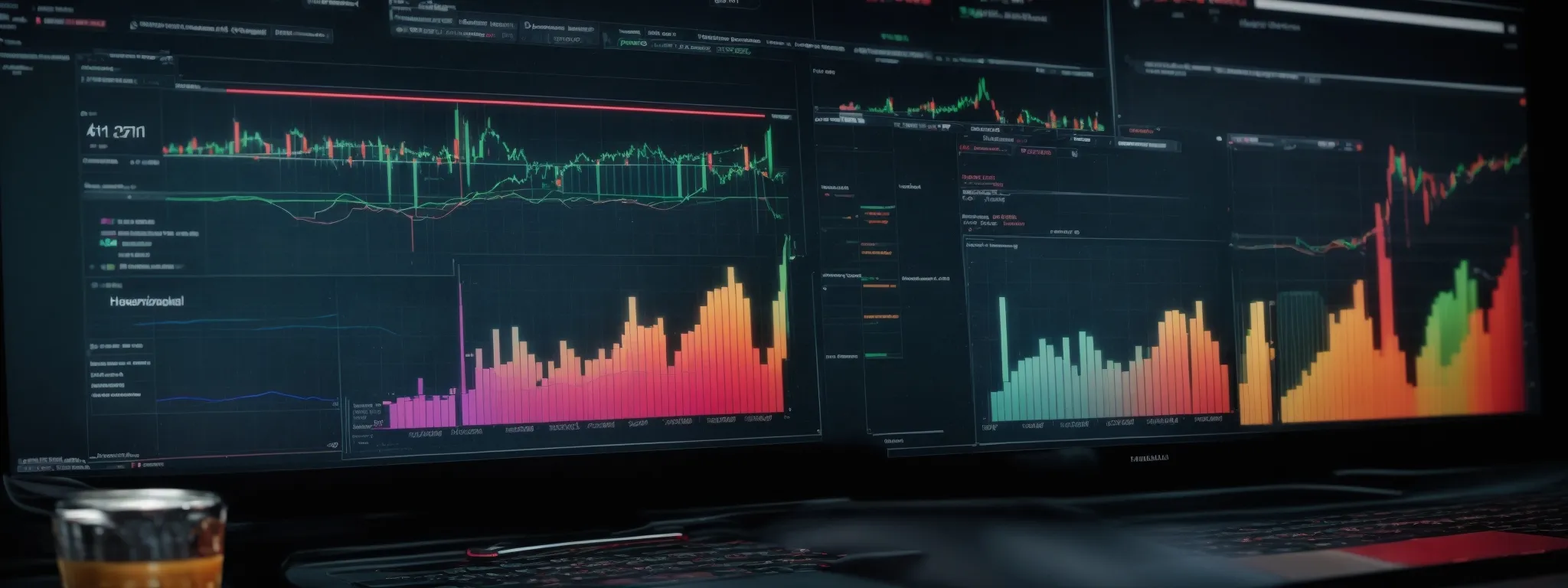Audience Insights: Tools and Winning Strategies
Mastering Audience Insights: Proven Tools and Strategies for Success In the dynamic realm of digital marketing, understanding one’s audience is tantamount to orchestrating a successful campaign. With […]
Mastering Audience Insights: Proven Tools and Strategies for Success
In the dynamic realm of digital marketing, understanding one’s audience is tantamount to orchestrating a successful campaign.
With the right tools and strategies, businesses can unlock the treasure trove of data that is audience insights, paving the way for personalized marketing and increased ROI.
This nuanced understanding goes beyond basic demographics to encompass behaviors, preferences, and loyalties, serving as the linchpin for targeted advertising and customer experience enhancement.
Companies equipped with this knowledge are empowered to anticipate needs and forge meaningful connections with their customer base.
Keep reading to explore the intricate tools and strategies that can elevate your grasp of audience insights to new pinnacles of precision.
Key Takeaways
- Audience Insights Extend Beyond Demographics and Include Behavior Patterns and Psychographics That Lead to Brand Loyalty
- Effective Utilization of Audience Insights Tools Is Fundamental for Personalized Marketing Campaigns and Strategies
- Audience Segmentation Ensures Each Marketing Communication Is Relevant and Tailored to the Interests, Needs, and Behaviors of Specific Consumer Groups
- Ethical Collection and Privacy of Audience Insights Are Vital for Maintaining Consumer Trust and Brand Integrity
- Continuous Refinement of Strategies Through Audience Feedback Is Key to Sustained Relevance and Customer Satisfaction
Unveiling the Importance of Audience Insights

Grasping the concept of audience insights serves as the foundation for any marketer poised to make decisive maneuvers in the competitive marketplace.
With an acute understanding of one’s target audience, businesses can refine their marketing strategy and maximize impact.
Audience insights extend beyond mere demographics, encompassing behavior patterns, preferences, and the deeper psychographics leading to brand loyalty.
This meticulous knowledge is instrumental for marketers, enabling them to identify their core demographic with precision and, in turn, tailor their messaging and product offerings to meet the exacting demands of the market.
Understanding the Basics of Audience Insights
At its core, audience insights condense a range of data points into coherent narratives about consumer behavior and preferences. This complex analysis offers companies a lens through which they can view the distinct segments of their market, each with its own set of characteristics and propensities.
Effective utilization of Audience Insights Tools equips businesses with the foresight needed to anticipate consumer needs and make informed decisions. This intelligence lays the groundwork for robust, personalized marketing campaigns and strategies, fostering a deeper connection between brand and consumer.
Key Benefits of Audience Insights for Marketers
Marketers reap substantial rewards from harnessing audience insights, most notably the enhancement of Marketing Effectiveness. By discerning the nuanced needs and desires of different consumer segments, marketing initiatives can be orchestrated with a laser-focused precision that resonates on a personal level, thus driving engagement and conversions.
The refined strategies stemming from audience analysis not only conserve resources but also fortify the brand’s reputation as a customer-centric business. Integrated audience insights pave way for communications that are empathetic and aligned with consumer sentiment, solidifying trust and loyalty to the brand over time.
Identifying Your Target Audience Effectively
Identifying your target audience with high precision is a strategic imperative that can considerably elevate the efficacy of marketing endeavors. Insightful demographic segmentation, paired with behavioral and psychographic analysis, ensures that communication strategies meet the audience exactly where they stand.
To achieve this, the deployment of specially tailored audience research tools is indispensable: these platforms collect and interpret diverse consumer data, transforming it into Actionable Insights for marketers:
- Understanding who the core customers are based on comprehensive data collection and analysis.
- Applying audience segmentation to categorize consumers according to specific attributes and behaviors.
- Utilizing these classifications to create personalized and engaging marketing messages that resonate with each unique segment.
By leveraging these insights with precision, brands not only sharpen their marketing strategies but also lay the foundation for sustained business growth. This strategic positioning, guided by a clear understanding of the target audience, is crucial in today’s dynamically evolving market landscape.
Top Tools for Gaining Insight Into Your Audience

In the realm of strategic marketing, the deployment of advanced analytical tools is indispensable for unlocking invaluable audience insights.
These tools are engineered to dissect vast data sets, gleaning the fine details that piece together a comprehensive picture of consumer behavior and preferences.
Marketers, therefore, must equip themselves with analytical platforms that not only capture a wide spectrum of consumer data but also offer intuitive features for robust data interpretation.
In the pursuit of excellence, discerning the subtleties that differentiate one tool from another can mean the difference between market dominance and obsolescence.
This overview will explore the features that set apart the most effective audience insight tools and compare top contenders shaping the future of consumer understanding.
Overview of Analytical Tools
Analytical tools are indispensable for marketers aiming to sharpen their audience insights. These Sophisticated Platforms dive deeply into consumer data, providing clarity on the nuances of behavior and needs that drive purchasing decisions.
Armed with these powerful tools, businesses can move beyond generic strategies by integrating rich, Data-Driven Insights that yield targeted and meaningful interactions with their audience. In navigating the complex digital landscape, smart use of these analytics becomes a cornerstone for success.
Features to Look for in Audience Insight Tools
In the quest for potent audience insights tools, intuitive usability interfaces with seamlessly integrated technology often emerge as critical factors. The tools advancing the practice of audience analysis provide clear, navigable dashboards that enable marketers to extract, interpret, and act on data without a steep learning curve.
Another hallmark of a superior audience insights tool is the capacity for real-time data analysis, which affords marketers the agility to respond promptly to market dynamics. The ability to track audience behavior and campaign performance concurrently ensures marketing strategies can be adapted with precision, aligned with the shifting landscape of consumer interactions.
Comparing the Best Tools on the Market
When evaluating the plethora of audience insight tools available, the distinct functionalities of SearchAtlas by LinkGraph set it apart as a forerunner in the digital marketing sphere. Its robust suite of SEO software and tools provides an unprecedented level of data accuracy and insight, ensuring that businesses secure a commanding understanding of their target market’s behavior and preferences.
LinkGraph’s SEO services excel, offering a comprehensive content planning tool and SEO Content Assistant designed to streamline content creation for SEO excellence. Instead of overwhelming users with raw data, SearchAtlas SEO software translates complex analytics into actionable strategies, embodying the precision and adaptability demanded by today’s digital marketers.
Crafting a Strategy for Audience Insight Analysis

Understanding the intricacies of consumer behavior is a strategic endeavor central to the success of any marketing campaign.
Crafting a meticulously outlined strategy for audience insight analysis is crucial for brands aiming to navigate the vast sea of customer data with precision.
Key to this process are structured goals that steer the insight collection, a well-considered plan for data gathering that compliments an organization’s resources and objectives, and a commitment to iterative refinement.
These principles, when adhered to, empower businesses with the clarity needed to distill data into actionable intelligence, thus propelling their marketing strategies to new heights of effectiveness.
Setting Clear Goals for Audience Insight Collection
Intentionality forms the crux of successful audience insight collection. Marketers must articulate specific, measurable objectives that guide the data they gather and the insights they seek to uncover: these goals may revolve around understanding purchasing patterns, quantifying brand sentiment, or gauging the effectiveness of targeted advertising.
Upon establishing these goals, businesses can construct a well-defined roadmap directing their audience analysis endeavors. A clear agenda ensures data collection efforts remain focused and relevant, enabling organizations to gain profound comprehension of their customers’ motivations and barriers to engagement.
| Objective | Insight Sought | Application |
|---|---|---|
| Purchasing Patterns | Identify frequent purchase triggers and intervals | Optimize product availability and marketing timing |
| Brand Sentiment | Measure customer perception and loyalty | Customize reputation management strategies |
| Targeted Advertising Efficacy | Analyze conversion rates and engagement levels | Enhance ad personalization and placement precision |
Planning Your Approach to Data Gathering
Embarking on the path to comprehensive audience insight requires a prudent approach to data gathering. Deciding which methodologies will be most effective demands deliberate consideration, ensuring the data collected is both relevant and robust.
Settling on a blend of qualitative and quantitative research methods is often a cornerstone of a balanced data gathering strategy. Employing tools that facilitate surveys, focus groups, and social media monitoring alongside sophisticated data analytics provides a multi-dimensional view of consumer behavior:
- Surveys yield direct feedback from consumer segments, revealing their explicit preferences and pain points.
- Focus groups offer a platform for in-depth discussion, unearthing more nuanced consumer insights.
- Social media monitoring captures the organic conversation surrounding a brand, offering real-time sentiment analysis.
- Data analytics consolidate consumer interactions into actionable insights, helping refine marketing and product development.
Iterative Processes for Greater Insight
Mastering audience insights does not conclude at the initial data interpretation; it mandates an ongoing, iterative process to evolve the strategy in line with the changing behaviors and preferences of the target market. Refinement of insights through continuous loops of analysis and application is a hallmark of a dynamic marketing approach that stays attuned to consumer exigencies and market trends.
Embracing this cyclical process allows marketers to repeatedly test hypotheses, assess the effectiveness of marketing campaigns, and adjust course as needed. It is this commitment to perpetual learning and optimization that ensures the relevance and accuracy of the insights gleaned, ultimately contributing to the resilience and adaptability of the brand’s marketing strategies.
Integrating Social Media Insights for a Fuller Picture

In today’s digitized age, the vast array of social media platforms presents a goldmine of insights that are indispensable for marketers aiming to finesse their understanding of their audience.
Engaging with these online communities through social media analytics and listening tools allows businesses to capture the pulse of consumer sentiment, identify trends in real time, and make data-backed decisions.
This comprises a methodology integral to modern marketing, as interpreting the wealth of social metrics unveils the preferences and behaviors of an audience in unparalleled depth.
Marketers equip themselves with a sharper, more comprehensive view of the consumer landscape by integrating these insights into their audience analysis framework.
Leveraging Social Media Analytics
Leveraging social media analytics is crucial for marketers as they distill voluminous social interactions into strategic insights. By studying metrics such as engagement rates and shares, businesses obtain a granular understanding of how content performs and resonates with their audience.
These analytics enable organizations to map out the customer journey on social platforms, pinpointing areas of strength and opportunities for engagement. Advanced analysis of these interactions guides brands toward crafting messages that captivate their audience and encourage brand advocacy.
Social Listening as an Insight Tool
Social listening platforms serve as a conduit, delivering critical insights by analyzing the cacophony of online conversations. Brands pivot from mere participants to astute observers, interpreting the sentiment and topical trends that echo through social media channels.
Through vigilant social listening, companies unveil customer perspectives, learning not only what is said but also the underlying emotions and intentions. This form of intelligence becomes a strategic asset, allowing brands to engage with their audience in a more informed and empathetic manner.
| Aspect | Benefit | Strategic Application |
|---|---|---|
| Consumer Sentiment | Uncovers emotional drivers behind conversations | Guides tone and empathy in brand messaging |
| Topical Trends | Identifies shifting interests and topics of discussion | Enables proactive content strategy alignment |
| Audience Engagement | Measures the impact of social interactions | Refines tactics for increased user involvement |
Interpreting Social Metrics Relevant to Your Audience
Delving into the realm of social media metrics unveils valuable data that, when properly interpreted, offers a dynamic view of campaign performance and audience engagement. Astute marketers realize the intricacies within these numbers — a high volume of likes or shares, for example, reveals resonant content that can inform future marketing efforts.
Recognizing the significance of such metrics, seasoned professionals employ them to adjust campaign tactics, ensuring each piece of content not only aligns with the brand ethos but also strikes a chord within the target community. This active interpretation serves as a compass, guiding ongoing social media strategy with a focus on sustained audience connection and brand relevance.
Utilizing Surveys and Questionnaires Effectively

In the quest for a deepened comprehension of audience dynamics, the strategic implementation of surveys and questionnaires stands as a pillar of market research.
Crafting well-designed inquiries is fundamental to extracting insightful information, while the careful selection of survey tools determines the breadth and depth of data acquired.
Once the responses are gathered, a meticulous analysis of survey results becomes pivotal, providing a window into the collective psyche of the audience.
Engaging with these methods empowers businesses to refine their understanding of consumer needs, preferences, and behaviors, thereby fortifying their marketing initiatives with data-driven certainty.
Designing Questions for Maximum Insight
Designing survey questions demands a strategic approach to elicit the richest data possible. By crafting queries that are clear, concise, and tailored to the target audience, marketers can avoid potential ambiguity and ensure the insights gathered are both reliable and actionable.
Relevant and thought-provoking questions are the heartbeat of any insightful survey. The precision in questioning paves the way for uncovering genuine customer preferences and behaviors, influencing pivotal marketing decisions:
- Quantitative questions streamline the process of generating statistically significant data.
- Qualitative questions open doors to nuanced understanding, offering depth in consumer sentiment.
- Demographic questions establish foundational knowledge about the audience makeup.
Selecting the Right Tools for Surveys
Selecting the most conducive tools for surveys is a pivotal step in audience research, determining the quality and depth of insights that marketers can extract. The choice hinges on the tool’s capacity to facilitate user-friendly survey creation, distribution across the relevant channels, and comprehensive data analysis capabilities.
To derive meaningful insights from survey data, the chosen platform must offer diverse question types and robust analytical features. This ensures not only a high response rate due to user engagement but also the ability to slice the data for granular analysis: a dual advantage that amplifies the value of the feedback received.
| Consideration Factor | Tool Capability | Impact on Survey Success |
|---|---|---|
| User Accessibility | Intuitive design and easy navigation | Promotes higher completion rates |
| Data Collection Flexibility | Varied question types and branching logic | Enhances the richness of responses |
| Analysis and Reporting | Advanced metrics and data segmentation | Drives actionable audience insights |
Analyzing Survey Results to Gain Audience Understanding
Analyzing survey results is a critical stage in audience analysis where businesses distill raw data into actionable consumer insights. The process involves a thoughtful review of responses to identify patterns, correlations, and anomalies that reveal the true sentiments and preferences of the audience.
In this analytical phase, the emphasis is placed on isolating actionable intelligence that can directly inform and refine marketing strategies. Marketers delve into the responses to draw out meaningful conclusions that strengthen their understanding of consumer behaviors and drive targeted engagement initiatives.
Mastering the Use of Analytics for Web Traffic Insights

Navigating the ocean of web analytics is essential for businesses striving to deepen their comprehension of audience behavior and engagement.
This analytical journey commences with the disciplined scrutiny of traffic data, which, when deftly interpreted, unearths a wealth of knowledge about audience patterns and interactions.
Mastering this data-driven domain is not solely about accumulating metrics but rather transforming them into strategic initiatives that resonate deeply with consumers.
Armed with analytics, the savvy marketer is equipped to turn every click and scroll into a calculated opportunity to refine their approach and captivate their target market.
Introduction to Web Analytics
Web analytics offer companies a comprehensive overview of their online presence, tracking everything from visitor behavior to site performance. These insights are critical for understanding how users interact with a website and where improvements can be made to enhance the overall user experience.
By leveraging web analytics, businesses can pinpoint areas that captivate their audience’s attention, as well as identify where they may be losing potential engagements. This continuous flow of intelligence guides marketing professionals in optimizing websites to better align with visitor expectations and conversion goals.
Interpreting Data for Audience Behavior
Interpreting data for audience behavior is a nuanced art that transforms raw analytics into marketing wisdom. Examining the way users interact with a site’s content, from the pages they linger on to the devices they use, provides an intricate map of consumer engagement and preferences.
These insights shape a company’s digital presence to align more closely with the user’s journey. Strategists dissect elements such as bounce rate and session duration, unraveling the narrative that data paints about a visitor’s experience:
- Pageview analytics reveal the story behind content popularity and user interest.
- Examination of traffic sources determines the effectiveness of marketing channels.
- Device usage statistics inform optimization strategies for cross-platform accessibility.
With such pinpointed insights, businesses refine their web offerings, nurturing an environment that captivates and retains their audience. This meticulous approach to data is what marks the difference between a business that understands its audience and one that merely collects information without actionable application.
Converting Traffic Data Into Actionable Strategies
Unlocking the strategic potential of web traffic analytics demands an astute interpretation of data that can spark pivotal improvements in engagement tactics. By sifting through each metric with strategic intent, companies can identify trends that inform content optimization, personalize user experience, and ultimately pave the way for a higher conversion rate.
Once this rich tapestry of traffic data is laid bare, it becomes the guiding star for deploying resources where they have the greatest impact. Strategies take shape in the form of enhanced keyword targeting, refined PPC Google Ads services, or even adjustments to the website’s user interface, each driven by concrete, data-backed insights for maximum efficacy.
Discovering the Power of Psychographics in Audience Insights

Exploring the depths of audience perspectives moves beyond basic demographic slices into the realm of psychographics, which illuminates the powerful drivers behind consumer decisions in an increasingly complex market.
Defining psychographics in audience analysis involves a deep dive into values, attitudes, interests, and lifestyles that shape buying behaviors.
To effectively gather such nuanced intelligence, sophisticated methods for collecting psychographic data are paramount.
When applied thoughtfully, these psychographic insights unlock new dimensions in marketing strategies, enabling brands to engage more intimately with consumers and craft messages that resonate on a profoundly personal level.
Defining Psychographics in Audience Analysis
In the multifaceted discipline of audience analysis, psychographics plays a pivotal role by zeroing in on the psychological components of consumer behavior. This form of data is crafted to reveal the values, interests, attitudes, and lifestyle preferences that drive purchasing decisions, offering a more complete understanding of what motivates individuals to engage with a brand or product.
Parsing through psychographic data allows businesses to establish rich, behavior-driven profiles that are indispensable for crafting highly targeted marketing strategies. Employing this deeper level of analysis, companies gain the ability to connect with their audience on a more personal and emotional plane, fostering campaigns that resonate well beyond surface-level attributes:
- Company narratives become aligned with consumer value systems, heightening relevance.
- Marketing communications are tailored to reflect shared interests, enhancing resonance.
- Brands develop more impactful positioning strategies based on nuanced lifestyle insights.
Methods for Collecting Psychographic Data
The quest for rich, psychographic insights demands a blend of creativity and precision in data collection methodologies. Marketers must tap into diverse tools such as in-depth interviews, which offer a direct line to the consumer’s psyche, revealing underlying motivations, beliefs, and attitudes that shape their relationship with brands and products.
Another dynamic method involves sentiment analysis through the monitoring of social media platforms, where consumers express their opinions and preferences openly. This approach not only garners spontaneous data but also captures the emotive forces driving brand perception and purchase decisions in a natural environment.
Applying Psychographic Insights to Marketing Strategies
Integrating psychographic insights into marketing strategies equips brands with the means to deliver messages that strike a chord with consumers on an intrinsic level. By tailoring marketing efforts to align with an audience’s values and lifestyle, companies foster more meaningful connections, driving both engagement and loyalty.
Capitalizing on psychographic data, marketing teams can orchestrate campaigns that not only appeal to the logical considerations of consumers but also resonate with their emotional and aspirational desires. This strategic use of deep-seated consumer insights ensures that every marketing initiative is a step closer to capturing the hearts and minds of the target demographic.
Effective Segmentation to Enhance Audience Insight

In the pursuit of optimizing marketing efficacy, embracing audience segmentation is non-negotiable.
This granular approach to dissecting the audience into manageable and homogenous groups based on shared characteristics underpins the refinement of marketing strategies and campaigns.
The benefits of this practice are multifold, contributing to a more personalized and impactful market penetration.
Executed with precision, these techniques aid marketers in crafting bespoke messaging that resonates with each discerning segment, paving the way for deeper customer engagement and sustained brand loyalty.
As we delve into the techniques for accurate audience segmentation and the subsequent personalization of marketing efforts, the overarching goal remains clear: to harness the power of data-driven insights for consistently superior audience engagement.
Benefits of Segmenting Your Audience
Audience segmentation empowers marketers with the capability to craft tailored messages that effectively resonate with distinct consumer groups. This focused approach ensures that every communication is relevant to the specific interests, needs, and behaviors of segmented demographics, enhancing the effectiveness of marketing campaigns.
When leveraged correctly, segmentation facilitates a greater return on investment by allowing marketers to allocate their resources towards the most receptive audience segments. This strategic precision mitigates wastage of marketing spend and maximizes the campaigns’ overall impact:
- Increases efficiency in targeting and messaging.
- Enables more personalized customer experiences.
- Drives higher conversion rates through relevant content delivery.
Techniques for Accurate Audience Segmentation
Marketers seeking precise audience segmentation must deploy a nuanced approach, harnessing both demographic and psychographic factors. The former includes age, income, and gender, while the latter dives deeper into consumer lifestyles, values, and personality traits, ensuring segments are carved out with a high degree of accuracy and relevance.
Employing advanced data analytics and insights tools, such as SearchAtlas by LinkGraph, propels this segmentation into actionable intelligence. These sophisticated platforms analyze patterns within audience behavior and consumer interaction, distinguishing unique segments that are primed for tailored marketing strategies.
Personalizing Marketing Efforts Based on Segments
Personalized marketing initiatives hinge on the strategic application of audience segmentation, turning general campaigns into focused communiqués that considerably heighten relevance and engagement. Such personalized efforts, underpinned by concrete data derived from tools like LinkGraph’s SearchAtlas, enable brands to convey their narratives in ways that resonate deeply with each segment’s unique characteristics and needs.
Profoundly impactful marketing techniques emerge when businesses treat each audience segment as a distinct entity, thereby fostering an environment where targeted messaging evokes a sense of individualized attention. By addressing the specific preferences and behaviors identified within each segment, companies strengthen customer relationships and elevate the likelihood of conversion through strategic, segment-specific outreach.
Learning From Customer Feedback and Reviews

The landscape of customer engagement is profoundly shaped by the voice of the consumer, where feedback and reviews become powerful catalysts for business growth and innovation.
As brands navigate through the complexities of market dynamics, the development of tools for monitoring customer feedback takes precedence, delivering rich reservoirs of data-driven insights.
Analyzing these reviews offers an intimate glimpse into audience needs and sentiment, fostering a deeper connection and understanding between businesses and their customers.
Ingraining these perspectives into the fabric of company strategies ensures responses are keenly attuned to customer feedback, propelling brands towards elevated service excellence and competitive agility.
Tools for Monitoring Customer Feedback
Monitoring customer feedback is an indispensable facet of audience insights, necessitating precision-enabled tools that can capture and process vast volumes of data. Brands that invest in robust feedback monitoring systems are empowered to decipher the intricate feedback patterns across various customer touchpoints.
Tools that specialize in feedback analysis, such as sentiment analysis software and customer review aggregators, provide businesses with the nuanced understanding needed to respond proactively. These tools analyze text for emotional cues, identify trends, and collate feedback from different sources, enabling marketers to address customer concerns swiftly and effectively:
| Feedback Tool | Function | Benefit to Audience Insight |
|---|---|---|
| Sentiment Analysis Software | Deciphers emotional undertones in text | Yields a deeper understanding of customer sentiment |
| Customer Review Aggregators | Compiles feedback from various platforms | Provides a centralized view of customer perceptions |
These technologies interpret direct input from the end-user, translating raw feedback into actionable insights that can significantly shape customer experience improvements. By integrating these tools into their insight strategies, organizations harness the authentic voice of the customer, ensuring their offerings align with the evolving expectations of their audience.
Analyzing Reviews for Deeper Audience Insights
Delving into customer reviews reveals a nuanced spectrum of audience insights that are critical for refining a brand’s strategic roadmap. This comprehensive analysis identifies patterns and outliers in feedback that spotlight areas for product enhancement, service improvement, and market opportunity exploration.
Extracting and acting on these insights culminates in a transformative approach to customer relationship management and product development. By systematically evaluating customer reviews, businesses foster a responsive culture that adapts in tandem with consumer preferences, ensuring sustained relevance and customer satisfaction.
- Analyze customer feedback trends to align product features with user expectations.
- Implement service adjustments based on recurring sentiments, optimizing customer satisfaction.
- Identify market gaps and opportunities through outlier feedback, driving innovation.
Implementing Feedback Into Business Strategies
Translating customer feedback into strategic business initiatives solidifies the link between consumer insights and tangible results. By systematically incorporating consumer suggestions and criticisms into business planning, companies demonstrate a dynamic, responsive approach that is deeply attuned to the market’s evolving needs.
Business strategies imbued with client feedback become living entities that adapt and grow in line with customer preferences and requirements. This practice not only enhances product and service offerings but also projects a brand image that is customer-focused and committed to continuous improvement.
| Feedback Element | Strategy Development | Expected Outcome |
|---|---|---|
| Product Feature Requests | Incorporate top-requested features in the next release cycle | Products align more closely with consumer desires, potentially increasing satisfaction |
| Service Delivery Critiques | Revise protocols and training to address identified concerns | Enhanced customer service delivery, leading to improved brand reputation |
| User Experience Suggestions | Optimize interfaces based on usability feedback | Streamlined user experience, which can boost engagement and reduce churn |
Best Practices for Maintaining Data Privacy and Ethics

In an era where data is king, mastering audience insights necessitates not only technological savvy but also a steadfast commitment to data privacy and ethics.
Marketers and businesses must navigate the complex terrain of data privacy laws and regulations, ensuring that each piece of consumer data is collected, stored, and deployed with the highest standards of privacy in mind.
Ethical collection of audience insights is paramount to maintaining consumer trust; transparency in data usage fortifies customer relationships.
As organizations leverage tools and strategies to unlock the power of audience data, embedding best practices for privacy and ethical considerations at every turn is not just a legal obligation but a strategic imperative that underpins their brand integrity and success.
Understanding Data Privacy Laws and Regulations
Navigating the intricate web of data privacy laws and regulations is a fundamental aspect of gathering audience insights. Companies must be versed in various international, federal, and state regulations, such as the General Data Protection Regulation (GDPR) and the California Consumer Privacy Act (CCPA), which govern the collection, storage, and usage of consumer data.
Strict adherence to these laws not only shields organizations from legal repercussions but also demonstrates a commitment to ethical standards. In the process of acquiring and applying audience insights, brands must ensure consumer information is handled with the utmost care, fostering trust and transparency within their target market.
Ensuring Ethical Collection of Audience Insights
Ensuring the ethical collection of audience insights is foundational to a trustworthy data strategy. Marketers have a duty to transparently communicate the purpose and use of data, obtaining explicit consent from users while strictly adhering to privacy guidelines.
Maintaining the integrity of audience data collection methods protects not only the privacy of individuals but also the reputation of the brand. This commitment to ethical practices is recognized and valued by consumers, often translating into enhanced loyalty and a stronger brand-customer relationship.
| Key Aspect | Practice | Impact on Ethical Data Strategy |
|---|---|---|
| Transparency | Clearly communicate data usage to users | Nurtures trust and secures informed consent |
| Compliance with Laws | Adherence to global and local data protection regulations | Prevents legal issues and ensures ethical standards |
| User Consent | Obtain explicit permission for data collection | Respects user privacy and reinforces data integrity |
Building Trust Through Transparent Data Usage
Building trust through transparent data usage hinges on an organization’s capacity to convey clarity regarding its data handling procedures. A brand that transparently communicates the specifics of data usage, such as how the data enhances user experience or drives personalized marketing, strengthens consumer confidence and trust in its practices.
Fostering a culture of transparency can transform user perception from one of skepticism to partnership. By openly sharing how data informs service improvements and ensures content relevancy, companies engender a collaborative relationship with their audience, fostering mutual respect and understanding.
- Transparency in data practices manifests as detailed privacy policies that articulate the nuances of how user data is leveraged.
- Clarity in data utilization, such as sharing anonymized insights that drive service innovation, reassures users of the ethical use of their information.
- Periodically communicating data handling updates to users fortifies the trust factor, as it demonstrates ongoing commitment to privacy standards.
Conclusion
Mastering audience insights is essential for effective marketing, as it enables brands to comprehend and connect with their consumers at a deeper level.
By utilizing a mix of sophisticated analytical tools such as SearchAtlas by LinkGraph, surveys, social media analytics, and web traffic data, companies can tailor their marketing strategies to match the nuanced preferences of different audience segments.
Integrating psychographics offers a further edge, enhancing the personalization of campaigns.
Effective audience segmentation and the strategic application of customer feedback into business strategies can drive higher engagement and foster brand loyalty.
However, amidst these efforts, upholding data privacy and ethics is critical to maintain consumer trust and comply with legal standards.
In summary, leveraging proven tools and strategies to gain audience insights not only boosts marketing success but also ensures sustainable growth and a strong ethical brand reputation.















































































